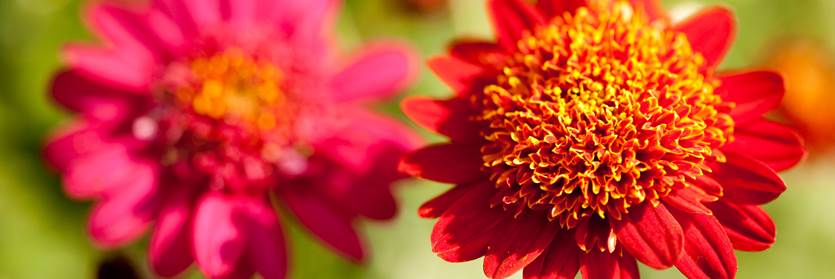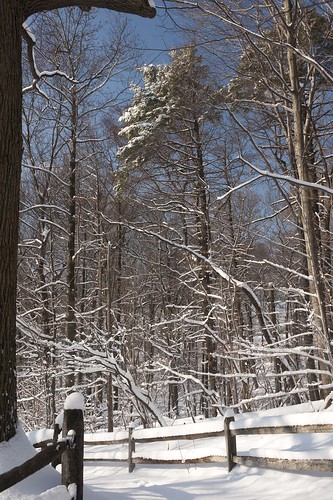Morning Eye Candy: Winter Wonderland
Posted in Photography on January 26 2011, by Plant Talk
It just keeps snowing here at the Garden. And it just keeps getting prettier, too.
Winter in the Bruckman Crabapple Collection (photo by Ivo M. Vermeulen)

Inside The New York Botanical Garden
Posted in Photography on January 26 2011, by Plant Talk
It just keeps snowing here at the Garden. And it just keeps getting prettier, too.
Winter in the Bruckman Crabapple Collection (photo by Ivo M. Vermeulen)
Posted in Wildlife on January 25 2011, by Plant Talk
| Chris Nagy is a Ph.D. student at CUNY, and a wildlife biologist at the Mianus River Gorge Preserve in Bedford, N.Y. |
 In December I had the opportunity to survey The New York Botanical Garden for Eastern Screech-Owls. I have been chasing Eastern Screech-Owls in the Bronx and Manhattan for nearly 7 years, as part of my Ph.D. research, and getting the chance to look for them in the Garden was a treat.
In December I had the opportunity to survey The New York Botanical Garden for Eastern Screech-Owls. I have been chasing Eastern Screech-Owls in the Bronx and Manhattan for nearly 7 years, as part of my Ph.D. research, and getting the chance to look for them in the Garden was a treat.
The easiest way to look for owls, if you’re willing to wander through the woods at night, is to play recordings of their vocalizations. Most owls communicate primarily through calls, and if there’s an owl nearby, it will probably call back when it hears your broadcast.
There have been no reports of Screech-Owls at the Garden for many years, and we didn’t find any this time either. (Ed. note – Though we have no Eastern Screech-Owls, the Garden is home to at least one Northern Saw-Whet Owl and a family of Great Horned Owls). But determining the places where owls are not is just as important as finding where they are.
By comparing the geographic location, habitat characteristics, and other variables in places where they are found versus where they are not, we can determine what features are important for a species. My hunch is that the absence of Eastern Screech-Owls at the Botanical Garden has more to do with the Garden’s location within the larger city than with any specific habitat quality. Alternatively, there also may be larger raptors at the Garden discouraging the smaller Screech Owls from readily calling back, or from making the Garden their home at all.
I’d like to thank NYBG staff, especially Jessica Arcate Schuler, for their help and allowing me to perform some of my research at the Garden.
Posted in Photography on January 25 2011, by Plant Talk
Four-season gardening can be as simple as ensuring your garden has something that will provide winter interest, like this wonderful hedge, Euonymus alatus ‘Compactus’ (commonly known as Dwarf Winged Euonymus or Dwarf Burning Bush) in the Seasonal Border.
We’ve Got Rhythm (Photo by Ivo M. Vermeulen)
Posted in Photography on January 24 2011, by Plant Talk
Squirrels. They have so much attitude. Where does it come from?
Squirrel! (photo by Ivo M. Vermeulen)
Posted in Photography on January 23 2011, by Plant Talk
”The time has come,” the Walrus said,
”To talk of many things:
Of shoes–and ships–and sealing-wax–
Of cabbages–and kings–
And why the sea is boiling hot–
And whether pigs have wings.”
Lewis Carroll – The Walrus and the Carpenter
Cyrtostachys renda Sealing Wax Palm (photo by Ivo M. Vermeulen)
Posted in Photography on January 22 2011, by Plant Talk
A popular common name for this flower is “Powderpuff.” Very little explanation needed as to why!
Calliandra emarginata (photo by Ivo M. Vermeulen)
Posted in Bill Buck, From the Field, Science on January 21 2011, by William R. Buck
Ed. note: NYBG scientist and Mary Flagler Cary Curator of Botany, Bill Buck is currently on expedition to the islands off Cape Horn, the southernmost point in South America, to study mosses and lichens. Follow his journeys on Plant Talk.
 January 20, 2011, Isla Grande de la Tierra del Fuego, Seno Bluff, Chile, 54° 26’S, 71° 18’W
January 20, 2011, Isla Grande de la Tierra del Fuego, Seno Bluff, Chile, 54° 26’S, 71° 18’W
After what seemed like an eternity of waiting (but was actually only five days), we were finally ready to leave.
We transported all our gear to the port and loaded it aboard our ship, the Don Jose Pelegrin, a commercial crabbing ship. The austral summer is when crabs breed, so crab fishermen are not able to fish, and we are able to rent this ship. In winter the ship works the sub-Antarctic seas catching the Southern Hemisphere equivalent of the Alaskan king crab (think World’s Deadliest Catch).
By any standard, this is a small ship (but obviously seaworthy). It is about 55 feet long by 17 feet wide; there is a small galley and from there you can access the bridge above or the bunkroom below by ladders. The bunk room is decidedly claustrophobic since I am unable (at 6 feet) to stand up in it. The 10 bunks are arranged in the shape of a capital E (my bunk is the lower one on the lower half of the upright of the E). It is something of a contortionist act to get in and out of the bunk, and once in the bunk there is well less than a foot from your body to the bunk above. Fortunately I am not inclined to claustrophobia since my attitude is that once I close my eyes, it doesn’t matter if it is 10 feet or 1 inch from me. At my request the hold that keeps the crabs has been fitted as a moss drying room. There is a small bathroom with a toilet and sink (no bathing facilities!) but today the toilet broke and so we need to go ashore in the woods for our bodily functions.
Bill and his colleagues finally set sail! Follow their adventures below.
Posted in Photography on January 21 2011, by Plant Talk
In the Conservatory.
Palm fronds (photo by Ivo M. Vermeulen)
Posted in Photography on January 20 2011, by Plant Talk
In the Conservatory.
Calathea zebrina ‘Humilior’ (Photo by Ivo M. Vermeulen)
Posted in Photography on January 19 2011, by Plant Talk
It’s not just flowers and foliage inside the Conservatory. We’ve got fruit too!
Citrus limon ‘Ponderosa’ (photo by Ivo M. Vermeulen)